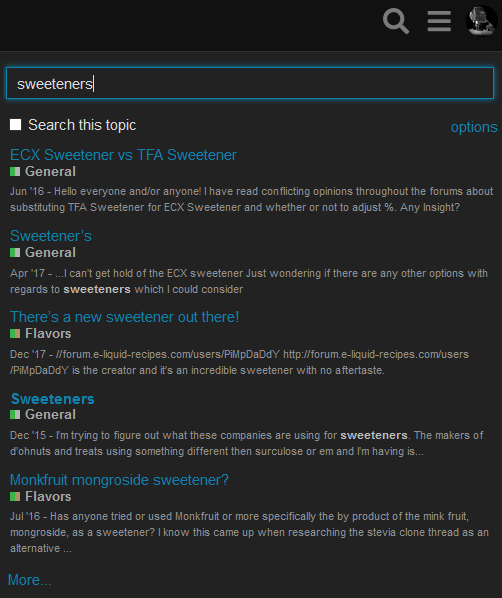I’ve searched at nomnomz and chefsflavours for TFA Ethyl Maltol but I didn’t find it. There are Ethyl Maltol of other brands but no TFA. Has TFA the Ethyl Maltol molecule?
Searching in this forum I found this thread about crystals by TFA but not liquid https://forum.e-liquid-recipes.com/t/ethyl-maltol-crystals-tpa/15503
Sorry, but I’m noob with DIY. Thanks!
6 Likes
Read the description here:
8 Likes
Thanks, that clears it all up!
Maybe thirds on-line shops should include it in the product title as do the official shop.
6 Likes
Welcome to ELR 
When you find what you’re searching for, does it even matter what brand is printed on the label? 
Most people here kinda know about sweeteners and which ones can be found in which concentrates so it’s really not needed that sellers have to alter manufacturer’s product names.
Don’t worry, you’re at the right place already. This section contains a wealth of information and I can only recommend that you read and learn a lot.
If you’re looking for sweeteners, especially as a beginner, you may want to try a different sweetener than (Ethyl) Maltol. It is not the strongest sweetener and has a tendency to mute flavors when you add more.
There are whole threads dedicated to sweeteners, it’s worth checking those out before checking out your cart at the flavor shop.
Just use the handy search function to dig them up:
8 Likes
Ethyl Maltol, EM
Mutagen, masks bitter / off notes. Adds some sweetness, use maybe at 1% or lower in combination with sweetener.
Higher percentages will get cotton candy flavor
“Maltol, ethyl maltol, and diacetyl are representatives of the 1,2-dicarbonyl class of chemicals. The total daily human doses of mutagenic 1,2-dicarbonyl compounds are likely to be much greater than estimates based on known levels of maltol, ethyl maltol, and diacetyl. Other 1,2-dicarbonyl compounds such as intermediates in enzymatic and nonenzymatic browning reactions in foods are weakly mutagenic in the Ames test. No conclusive evidence showing the carcinogenic activities of these substances has been presented.”
“Maltol, ethyl maltol (Figure 5.12), and diacetyl are weak mutagens. However, relatively large amounts of the substances are present in the diet. The usual levels of maltol added to baked goods, ice creams, and candy are approximately 110 ppm. Levels on the order of 80 ppm are added to certain beverages. Ethyl maltol, a more potent flavor enhancer than maltol, is generally used in concentrations of about 20 ppm in these foods.”
“Masking is the addition of flavors to minimize the detectability of off-flavors. The methods include: taste modifying by providing other sensations, taste suppression by competing with bitter receptors (blocking), or accentuating other flavors (taste enhancing) (Gascon, 2011).
Sweetness often is enough to mask bitter flavors, since bitter and sweet receptors are similar in structure. However, just adding more sucrose may not be the answer, Maltol, vanillin, and MCP all smell “sweet,” that is, they possess aromas that are associated with sweet foods (think ice cream, sweet bakery items, and maple syrup). Added to a food with a bitter component, the sweet aroma will trick the mind into ignoring the bitter component as it is not congruent with the sweet taste and aroma.”
“Maltol is often added as a sweetness enhancer, but it also enhances and modifies savory flavors, adds mouthfeel, increases creaminess and dairy notes and decreases bitterness.”
4 Likes
Thanks for that. You learn something every day.
3 Likes
